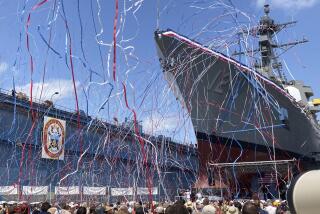50 Years After Iwo Jima, a Tribute to a Costly Fight
- Share via
ARLINGTON, Va. — Kitano Point, Bloody Gorge and Mt. Suribachi are not names one hears much anymore. Even the heroes who died in those places, men such as Charles Joseph Berry and John Harlan Willis and Donald Jack Ruhl, are remembered today mainly by their families and the other men who journeyed with them into a little patch of hell called Iwo Jima.
But Sunday, on the 50th anniversary of the battle, a couple of thousand old warriors, many accompanied by their wives, assembled at the foot of the famous Marine Corps War Memorial to receive tribute from a commander in chief, four Medal of Honor winners and a crowd that stood in silent awe.
“The dimensions of their struggle still stagger us,” President Clinton said.
“With our eyes closed, we can all still see the flag rising atop the hill.”
The President stood in front of the 78-foot bronze statue of that flag-raising, captured on film four days after the landing and then transformed into the very symbol of the Corps.
*
“Hard men wept when they saw the flag fly over Suribachi,” Clinton said.
“We fought one of the most costly battles in Marine Corps history on that eight-mile-square chunk of rock and volcanic ash--80,000 fighting men, Japanese and American, locked in close, savage combat,” retired Marine Col. William E. Barber told his old mates.
“I am older now, as are you, but I can still see the colors of that February morning. The sky. The island. And sometimes I think I can still hear the noise of battle.”
In their 60s and 70s, these old Marines walked away with a slightly more noticeable spring in their steps; their battle is not yet forgotten, and their sacrifice is not yet unappreciated.
Casualty figures hardly ever tell the story of a battle, but on Iwo Jima they come close.
The Marines, with supporting Navy units, landed on the island on Feb. 19, 1945. On the first day, there were 2,400 U.S. casualties.
The operation was supposed to take 14 days, but it took 36. At the end, 6,821 Americans had been killed; more that 16,000 Americans were wounded, many of them in savage hand-to-hand combat.
Of the 20,000 Japanese defenders, fewer than 1,100 survived.
It was the most costly fight in U.S. Marine Corps history. More Medals of Honor--27--were given for this fight than in any other World War II battle, but more than half of the recipients had died on the island.
*
“Uncommon valor was a common virtue,” Adm. Chester W. Nimitz said of the men who fought there. President Franklin D. Roosevelt, Clinton told the crowd, “gasped in horror” when he heard the casualty reports.
“The thing I remember most about the battle was the burial site,” said Art Huffer, 69, who fought in the 5th Marine Division. “There were a pile of bodies, and they had to dig a hole with a bulldozer.”
Bronze star winner Joe Noll, 74, recalled his reaction.
“I was made a platoon sergeant because my platoon leader was hit. We were up on the front lines on the sixth day when we ran out of C-2 explosives. Our Jeep was blown up and I took five of my guys and we ran down to the beach to get some more. I slipped on the guts of a Marine who’d been killed and my body turned around. And then I saw it, our flag flying! What a hell of a good feeling it was.”
Other major Iwo Jima reunions were held during the weekend in Atlanta, Philadelphia, San Antonio and Covina.
A 50th anniversary commemoration will be held on Iwo Jima on March 14.
More to Read
Sign up for Essential California
The most important California stories and recommendations in your inbox every morning.
You may occasionally receive promotional content from the Los Angeles Times.













